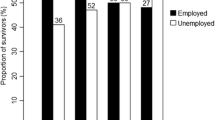Abstract
Goals of work
The goal of this study was to explore living conditions among disease-free cancer survivors participating in the labour force after successful primary treatment. Their living conditions were compared with the conditions of matched controls from the general Norwegian population.
Patients and methods
Living conditions are social indicators that stimulate social inclusion and reduce exclusion such as economy, employment, health, housing and social participation. A questionnaire covering living conditions with established questions from population surveys was mailed to 852 cancer survivors and 1,548 controls. Valid responses were obtained from 51% cancer survivors (216 women with breast cancer, 49 men with prostate cancer, and 165 with testicular cancer) and 39% controls (317 women and 279 men).
Main results
Compared to their controls cancer survivors showed no difference in work hours or full-time jobs, but reported significantly poorer physical and mental work capacity. This was associated with significantly more somatic diseases among survivors and poorer general health status in male survivors. The survivors had significantly smaller households and more living space than controls. No significant differences were observed concerning economy or social participation, except that significantly more female survivors than controls stated that they had enough friends.
Conclusions
In spite of poorer health, tumour-free survivors after breast, testicular, and prostate cancer report mostly equal living conditions compared to matched controls. The protection hypothesis of holding jobs as a precondition for normal living condition was confirmed in our study of a sample of cancer survivors with good outcome.

Similar content being viewed by others
References
Arozullah AM, Calhoun EA, Wolf M, Finley DK, Fitzner KA, Heckinger EA, Gorby NS, Schumack GT, Bennett CL (2004) The financial burden of cancer: estimate from a study of insured women with breast cancer. J Support Oncol 3:271–278
Atkinson T, Cantillon B, Marlier E, Nolan B (2002) Social indicators. The EU and social inclusion. Oxford University Press, Oxford
Bednarek HL, Bradley CJ (2005) Work and retirement after cancer diagnosis. Res Nurs Health 28:126–135
Bradley CJ, Bednarek H (2002) Employment patterns of long-term cancer survivors. Psychooncology 11:188–198
Bradley CJ, Bednarek HL, Neumark D (2002) Breast cancer and women’s labour supply. Health Serv Res 37:1309–1328
Bradley CJ, Bednarek HL, Neumark D (2002) Breast cancer survival, work, and earnings. J Health Econ 21:757–779
Bradley CJ, Bednarek HL, Neumark D, Schemk M (2005) Short-term effect of breast cancer on labor market attachment: result from a longitudinal study. Health Econ 24:137–160
Cancer Registry of Norway (2002) Cancer in Norway 2000. Cancer Registry of Norway, Institute of Population-based Cancer Research, Oslo
Dahl A, Haaland CF, Mykletun A, Bremnes R, Dahl O, Klepp O, Wist E, Fosså SD (2005) Study of anxiety disorder and depression in long-term survivors of testicular cancer. J Clin Oncol 10:2389–2395
Erikson R, Goldtorpe JH (1992) The constant flux. A study of class mobility in industrial societies. Clarendon, Oxford
Krokstad S, Westin S (2002) Health inequalities by socioeconomics status among men in the Nord-Trøndelag health study, Norway. Scan J Public Health 30:113–124
Kunst AE, Mackenbach JP (1994) Measuring socioeconomic inequalities in health. WHO Regional Office for Europe, Copenhagen
Kåresen R, Langmark F (2000) Kreftopererte kvinners psykiske, sosiale og økonomiske forhold (in Norwegian). Tidskr Nor Lægeforen 120:2741–2748
Lauzier S, Mausell E, De Koninck M, Drolet M, Hébert-Croteau N, Robert J (2005) Conceptualization and sources of costs from breast cancer: findings from patient and caregiver focus groups. Psychooncology 14:351–360
Main DS, Nowels CT, Cavender TA, Etschamaier M, Steiner JF (2005) A qualitative study of work and work return in cancer survivors. Pschooncology 14:992–1004. DOI 10.1002/pon.913
Maunsell E, Brisson C, Dubois L, Lauzier S, Fraser A (1999) Work problems after breast cancer: an exploratory qualitative study. Psychooncology 8:467–473
Maunsell E, Drolet M, Brissin J, Brisson C, Mâsse B, Deshênes L (2004) Work situation after breast cancer: result from a population-based study. J Nat Cancer Inst 24:1813–1822
Short PF, Vasey JJ, Tunceli K (2005) Employment pathways in a large cohort of adult survivors. Cancer 103:1292–1301
Spelten ER, Sprangers MAG, Verbeek JHAM (2002) Factors reported to influence the return to work of cancer survivors: a literature review. Psychooncology 11:124–131
Spelten ER, Verbeek JH, Uitterhoeve AL, Ansink AC, van der Lelie J, de Reijke TM, Kammeijer M, de Haes JC, Sprangers MA (2003) Cancer, fatigue and the return of patients to work—a prospective cohort study. Eur J Cancer 39:1562–1567
Office for National Statistics (2000) Standard occupational classification 2000 (SOC2000). http://www.statistics.gov.uk/methods-Quality/ns_sec/soc2000.asp
Statistics Norway (2005) http://www.ssb.no
Steiner JF, Cavender TA, Main DS, Bradley CJ (2004) Assessing the impact of cancer on work outcomes. What are the research needs? Cancer 8:1703–1711
Taskila-Åbrandt T, Pukkala E, Martikainen R, Karjalainen A, Hietanen A (2004) Employment status of Finnish cancer patients in 1997. Psychooncology 14:221–226
Verbeek J, Spelten E, Kammeijer M, Spangers M (2003) Return to work of cancer survivors, a prospective cohort study into quality of rehabilitation by occupational physicians. Occup Environ Med 60:352–357
Veronesi U, von Kleist, Redmond K, Costa A, Delvaux N, Freilich G, Galus A, Hudson T, McVie JG, Macnamara C, Meunir F, Pecorelli S, Serin D, CAWAC Study Group (1999) Caring about women and cancer (CAWAC): a European survey of the perspectives and experiences of women with female cancer. Eur J Cancer 12:1667–1675
Acknowledgements
This study was sponsored by a research grant from The Norwegian Foundation for Health and Rehabilitation (grant no. H0-54010/002) and a grant from the Nordic Cancer Union.
Author information
Authors and Affiliations
Corresponding author
Rights and permissions
About this article
Cite this article
Gudbergsson, S.B., Fosså, S.D., Borgeraas, E. et al. A comparative study of living conditions in cancer patients who have returned to work after curative treatment. Support Care Cancer 14, 1020–1029 (2006). https://doi.org/10.1007/s00520-006-0042-9
Received:
Accepted:
Published:
Issue Date:
DOI: https://doi.org/10.1007/s00520-006-0042-9




